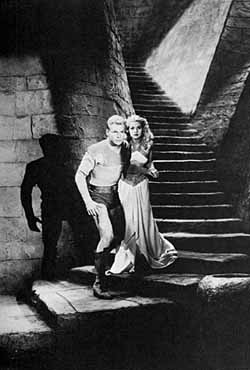|

Buster Crabbe and Jean Rogers
in Flash Gordon.
Universal was also working with a comic strip at the height of its popularity. Appearing in most Sunday comic pages across the country, Flash Gordon captured the imaginations of the American public. Artist Alex Raymond (who also drew Jungle Jim, Secret Agent X-9, and Rip Kirby) provided fantastic drawings that evoked an action-filled world of strange beasts, winged men, lustful passions, and futuristic cities. The serial actually followed the comic strip fairly closely, certainly more closely than any other serial followed its source.
Much of the success for Flash Gordon must be credited to Buster Crabbe and Jean Rogers. Crabbe treated the material seriously and delivered even the silliest lines of dialogue with a rare gusto. (He must say "Steady, Dale!" at least a dozen times.) Whereas many other actors might have treated the material as beneath them and tried to distance themselves from the characters they played, Buster Crabbe threw himself into the role with never an indication that the material might be nonsense. Jean Rogers, as Flash's girlfriend Dale Arden, became one of the most endearing heroines in the history of serials, even if she had an annoying habit of passing out from fright. She certainly looked absolutely fabulous in a tight two-piece outfit that exposed her bare midriff and emphasized her breasts. Rogers was a fragile creature who the villains delighted in terrorizing. In one scene, King Vultan (before he becomes Flash's ally) threatens her with a bear. She screams and presses back against a wall, her stomach sucked in so that her ribs stick out and her breasts practically pop through her brassiere. She breathes deeper and deeper, practically hyperventilating as King Vultan closes in on her, his eyes crazed.
See Dale Arden menaced by the terrible King Vultan,
an excerpt from Flash Gordon.
(Animated GIF, 25 frames, 180 KB)
We also get plenty of scenes where Flash is imperiled. In one scene, Ming the Merciless has him thrown into a pit to fight four fanged monkey men. They promptly rip off his shirt, exposing his well-oiled biceps. Scenes such as these reveal that Universal was hoping to attract more than simply popcorn-chomping children to the theaters. And on those terms, the studio was wildly successful.
Instead of playing matinees, Flash Gordon was booked into some of the finest theaters, and audiences of all ages flocked to the engagements. With the success of Flash Gordon, the studios quickly learned that comics were fertile material for the serials, for the readers were anxious to see their heroes on the screen. Soon the serials gave us The Adventures of Captain Marvel, Spy Smasher, Dick Tracy, The Phantom, Buck Rogers, Batman, Ace Drummond, and many others. Radio dramas also provided promising material, and soon The Green Hornet, The Lone Ranger, and The Shadow hit the screen in serial form.
With interest at its highest level since the days of Pearl White, serials entered their golden age--especially after upstart Republic Studios, the home of Roy Rogers and Gene Autry, began serial production and introduced improved production methods, effective special effects, talented composers, and the best directing team, William Witney and John English, in the history of the serial.
 page 3 of 5
page 3 of 5
 
The Serials: An Introduction
Page 1: In the Theaters
Page 2: The Beginnings
Page 3: Enter Flash Gordon
Page 4: The Golden Age
Page 5: The Downfall
The Phantom Empire
Flash Gordon
Dick Tracy
The Fighting Devil Dogs
Zorro's Fighting Legion
The Shadow
Mysterious Dr. Satan
Spy Smasher
Perils of Nyoka
The Tiger Woman
Serials Web Links
|



